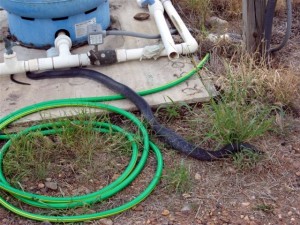

They inhabit a wide variety of habitat, ranging from prairies to wooded mountains. Individuals often return to the same den year after year, migrating to hunting territories after waking. Prairie rattlesnakes hibernate in winter and sometimes congregate in hibernation dens. Predators include mammalian carnivores, raptors and king snakes. Mortality rates are high in the first year. Smaller snakes may give birth to as few as 5 young, larger mothers as many as 25 young. Litter size is proportionate to the size of the female. Young are born between August and October.

Mating usually happens between mid-summer and early fall. Unsurprisingly, the rattlesnake has a rattle, to which it adds a new segment each time it sheds its skin. Growing around 35-45 inches in length, the snake is usually a greenish gray, olive green or greenish brown, though some individuals are light brown or yellow. However, these venomous snakes will live in prairie dog tunnels once the original inhabitants have left or been digested.Īs its name implies, the prairie rattlesnake’s range is centered in the middle of the United States, from Canada south to Texas and from Idaho east to Iowa. In fact, prairie rattlesnakes will eat owl and prairie dog young, not a very neighborly gesture. Sadly, apocryphal stories of prairie rattlesnakes harmoniously sharing burrows with prairie dogs and burrowing owls are untrue.


 0 kommentar(er)
0 kommentar(er)
